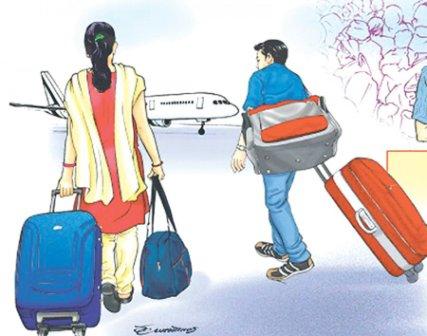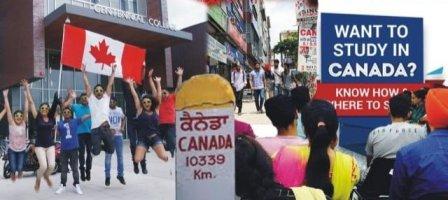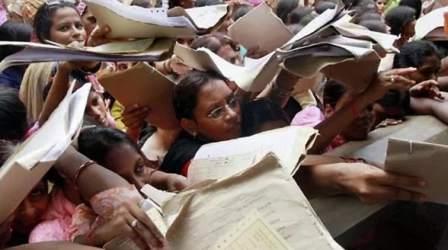

The dichotomy is glaring. After all, if India is poised to become a US $ 5 trillion economy by 2027-28 or at best by 2030, why is that the youth and for that matter even the super-rich are trying to flee the country in large numbers.
Still more importantly, aren’t they excited at the immense possibilities that the fastest growing among the major economies is expected to throw open once India leaves behind Japan and Germany to emerge as the third largest economy, and that too before 2030, as per the projections of the global investment bank Morgan Stanley?
 Skipping the usual route of rural to urban migration that the policy makers had encouraged all these years, the youth have charted a new migratory route – straight from the villages to the foreign countries.
Skipping the usual route of rural to urban migration that the policy makers had encouraged all these years, the youth have charted a new migratory route – straight from the villages to the foreign countries.
Not only the youth, the super-rich too have been increasingly giving up Indian citizenship and looking for opportunities to settle abroad. These high net-worth individuals (HNWI), as they are generally referred to, have liquid assets exceeding $ 1 million that are available for investment.
Since 2011, more than 16-lakh rich Indians have given up citizenship, including 183,741 this year, Parliament was informed. “The exodus of 2022 takes the total number of Indians renouncing Indian citizenship under the government in the past nine years since 2014 to over 12.5-lakh people,” Mahua Moitra from the TMC had said in Parliament recently.
I thought the rich should have instead waited for some more time to look for better economic and business opportunities in the years to come that the government has been promising. But with developed countries providing citizenship to the high net-worth individuals, an increasing number of the rich within the country has been slowly moving out.
 After amassing wealth within the country, these super-rich are moving abroad looking for a better living environment. The loss that the domestic economy suffers with such families moving out becomes an economic gain for the country granting citizenship.
After amassing wealth within the country, these super-rich are moving abroad looking for a better living environment. The loss that the domestic economy suffers with such families moving out becomes an economic gain for the country granting citizenship.
Nevertheless, let’s return back to the worrying trend of growing migration among the youth and that too in search of higher education. While this is a clear indictment of the dismal education quality standards that prevail here, and add to it the lack of suitable employment opportunities, the youth are looking for greener pastures abroad.
Sadly, instead of improving higher education standards, many state governments are helping by supporting those who are keen to seek admission in foreign universities. In Punjab, support is available for IELTs examinations.
Most of those who go abroad for education have sold their farm lands, mortgaged their property and have drawn loans. On an average each student incurs about Rs 25-lakh to Rs 30-lakh for education abroad thereby transferring a significant amount every year from the domestic economy.
 While education as a service is WTO compatible under Mode 2 trade in services for consumption abroad, the world has not opened up for free movement of people. This has enabled young students to seek admission into an educational institute abroad, and thereby add onto to the economy of the host country.
While education as a service is WTO compatible under Mode 2 trade in services for consumption abroad, the world has not opened up for free movement of people. This has enabled young students to seek admission into an educational institute abroad, and thereby add onto to the economy of the host country.
Every student who goes abroad for education goes with the hope of getting an authorisation for permanent residence. A better living standard, higher wages and a heightened social security is what lures the students to settle abroad.
For several years now Punjab, Kerala and now Haryana have seen a steady outflow of skilled manpower. While earlier both the states were known to be catering for job opportunities abroad, the focus has not shifted to education.
From Punjab alone, an estimated 1.5-lakh student have been migrating every year; and about 35,000 students from Kerala travel abroad for education. In Haryana, the craze for going abroad for education has now caught up, with IELTs centres and visa shops becoming a common sight.
 The first preference is for educational institutes in Canada, US, UK, France, Australia, Italy and New Zealand. Those who cannot make it to these primary destinations are finding educational openings in Russia, Georgia, Latvia, Belarus, and Uzbekistan besides a number of other Eastern European countries.
The first preference is for educational institutes in Canada, US, UK, France, Australia, Italy and New Zealand. Those who cannot make it to these primary destinations are finding educational openings in Russia, Georgia, Latvia, Belarus, and Uzbekistan besides a number of other Eastern European countries.
Soon after the Russia invasion of Ukraine, India had brought back nearly 22,500 students (between Feb and July this year). A majority of those evacuated were studying medical sciences.
Call it ‘brain drain’ but the flight of the youth in search of better education abroad is making Punjab, Haryana and Kerala devoid of the younger generation. At this rate, these states are fast turning into old age homes. In economic terms, all this will impact domestic demand.
Perhaps an inkling of how an education deficit and failure to promote job creation has left a huge gap in all-round development comes from an interesting article written by the former RBI governor Raghuram Rajan et al (Times of India, Jan 4, 2023).
Quoting the National Family Health Survey, the authors say that the land holdings had shrunk by 22 per cent within a five year period, between 2015-16 and 2019-21.
 For the small farmers, land holdings came down by 8.5 per cent annually. This only shows that farmers found it worthwhile to sell their land to make a living. Although the data does not point to, but much of the land sales may be to fund for higher education of their children.
For the small farmers, land holdings came down by 8.5 per cent annually. This only shows that farmers found it worthwhile to sell their land to make a living. Although the data does not point to, but much of the land sales may be to fund for higher education of their children.
With the Centre for Monitoring Indian Economy (CMIE) and the Ashoka University reporting that nearly 1.4-crore fewer Indians were employed in Oct 2022 as against January 2020, a period of three years. The hardest hit were young people in the range of 15-39 age bracket.
Earlier, a CMIE report had said that a majority of 90-coroe workforce had stopped looking for jobs. Put together, it spells out the reasons for the growing disenchantment among the youth. That is why the impressive growth recovery and the promise of attaining the status of a $5 trillion economy in a few years from now, does not enchant the younger generation.
 Simply put, growth alone is not the factor that can meet the aspirations of a growing population. Unless the focus reverts back to rebuilding education, making it easily accessible, affordable and is of high quality; and addressing the looming unemployment crisis, the youth are unlikely to be adequately motivated to stay back and add to the growing economy.
Simply put, growth alone is not the factor that can meet the aspirations of a growing population. Unless the focus reverts back to rebuilding education, making it easily accessible, affordable and is of high quality; and addressing the looming unemployment crisis, the youth are unlikely to be adequately motivated to stay back and add to the growing economy.
This is a challenge, and certainly within the means of the government provided the emphasis truly shifts to realise the vision of Sabka Saath Sabka Vikas. ![]()
___________
Also Read:
TRUTH VS FALSEHOOD: BBC – Who is afraid?
Mughal Gardens – Name Changed, But Why?
Industrialization versus Environmental Degradation
Punjab – How a deadly cocktail of Agri-Water-Energy nexus going to destroy it?

Disclaimer : PunjabTodayTV.com and other platforms of the Punjab Today group strive to include views and opinions from across the entire spectrum, but by no means do we agree with everything we publish. Our efforts and editorial choices consistently underscore our authors’ right to the freedom of speech. However, it should be clear to all readers that individual authors are responsible for the information, ideas or opinions in their articles, and very often, these do not reflect the views of PunjabTodayTV.com or other platforms of the group. Punjab Today does not assume any responsibility or liability for the views of authors whose work appears here.
Punjab Today believes in serious, engaging, narrative journalism at a time when mainstream media houses seem to have given up on long-form writing and news television has blurred or altogether erased the lines between news and slapstick entertainment. We at Punjab Today believe that readers such as yourself appreciate cerebral journalism, and would like you to hold us against the best international industry standards. Brickbats are welcome even more than bouquets, though an occasional pat on the back is always encouraging. Good journalism can be a lifeline in these uncertain times worldwide. You can support us in myriad ways. To begin with, by spreading word about us and forwarding this reportage. Stay engaged.
— Team PT


Copyright © Punjab Today TV : All right Reserve 2016 - 2024 |